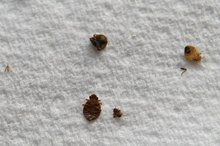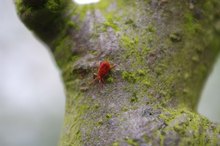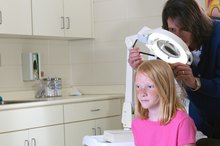What does fact checked mean?
At Healthfully, we strive to deliver objective content that is accurate and up-to-date. Our team periodically reviews articles in order to ensure content quality. The sources cited below consist of evidence from peer-reviewed journals, prominent medical organizations, academic associations, and government data.
The information contained on this site is for informational purposes only, and should not be used as a substitute for the advice of a professional health care provider. Please check with the appropriate physician regarding health questions and concerns. Although we strive to deliver accurate and up-to-date information, no guarantee to that effect is made.
Types of Tiny Black Bugs Found in the Bed
Insects are one of the last things you want to encounter in your bed, but microscopic creatures are nevertheless present in mattresses of all kinds. No matter how clean you keep your sleeping quarters, you may be frustrated to find that these uninvited organisms continue to make themselves known. Parasitic bugs are often hard to spot and even more difficult to get rid of, but factual information on the tiny pests will go a long way toward prevention and eradication.
Common Bedbug
The common bedbug, an epidemic source of agony and turmoil around the world, is elusive during the day but active at night. These small insects feed off of human hosts, creating tiny swollen bumps where they bite. They like to hide in the nooks and crannies of mattresses and are often good at concealing themselves. Bedbugs are adept at adjusting to their host's environment. They are flat, wingless and may appear black in color though they are actually a deep brown. Tiny spots of human blood on a mattress may indicate the presence of feeding bedbugs in the vicinity.
- The common bedbug, an epidemic source of agony and turmoil around the world, is elusive during the day but active at night.
Fleas
Differences Between Bedbugs & Chiggers
Learn More
Pet owners should take care to monitor their animals for fleas, since a furry carrier can quickly lead to a mattress infestation. Fleas can be easily spotted on the surface of the bed, because they're not concerned with burrowing inside of the mattress or box spring. Wash the sheets and all other bedding in a regular laundry cycle to get rid of fleas, and vacuum the mattress. This type of bug usually travels up to the mattress from the floor, where it dwells more comfortably. Treat the areas underneath and around the bed with flea-repellent products to keep them at bay, and make sure your pet is well-groomed and clean at all times.
- Pet owners should take care to monitor their animals for fleas, since a furry carrier can quickly lead to a mattress infestation.
- This type of bug usually travels up to the mattress from the floor, where it dwells more comfortably.
Dust Mites
Dust mites reside in house dust, and they provoke an allergic reaction in some people. These tiny bugs can not be spotted without a microscope. They are related to spiders, and they feed on human skin cells. Dust mites enjoy warmth and humidity, so bedding and mattresses provide the ideal environment for their growth. Allergic reaction, such as wheezing and a stuffy nose upon waking, is usually the only sign of dust mites. They are difficult to completely avoid, but washing your bedding regularly should minimize the problem. Avoid dust as often as you can, and treat your allergies with medication and home remedies 3.
- Dust mites reside in house dust, and they provoke an allergic reaction in some people.
- They are difficult to completely avoid, but washing your bedding regularly should minimize the problem.
Considerations
Red Itchy Bites on the Skin
Learn More
Bedbugs have become widespread in many cities around the world, infesting the mattresses of the unsuspecting humans from which they feed. At the first sign of small, itchy, red bumps on your skin, check the crevices and lining of your mattress to locate the problem. Call in a professional consultant if needed. It's wise to throw away an infected mattress, as there is no ensuring that bedbugs won't resurface. Often, clothes and bedding must also be disposed of after an infestation in the home. While less insidious types of bugs will disappear with a simple washing or two, bedbugs are much more stubborn and annoying to human hosts.
- Bedbugs have become widespread in many cities around the world, infesting the mattresses of the unsuspecting humans from which they feed.
- While less insidious types of bugs will disappear with a simple washing or two, bedbugs are much more stubborn and annoying to human hosts.
Related Articles
References
- Orkin: Bedbugs- General Facts
- Mayo Clinic:: Definition
- Mayo Clinic: Lifestyle and Home Remedies
- Bedbugs: Diagnosis and Treatment. American Academy of Dermatology. https://www.aad.org/public/diseases/itchy-skin/bedbugs.
- Bed Bug FAQs. Centers for Disease Control and Prevention. https://www.cdc.gov/parasites/bedbugs/faqs.html.
- How to Find Bed Bugs. United States Environmental Protection Agency. https://www.epa.gov/bedbugs/how-find-bed-bugs.
- Studdiford JS, Conniff KM, Trayes KP, Tully AS. Bedbug Infestation. American Family Physician. 2012 Oct 1;86(7):653-658.
Writer Bio
Lauren Tyree started writing professionally in 2010 as a staff writer for Poptimal. She has penned articles and essays since childhood. Tyree earned her Bachelor of Arts in sociology at Vassar College and her Master of Arts in communication at Regent University.







